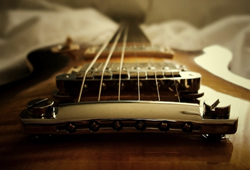Here’s an excerpt from The Ultimate Guitar Tone Handbook, available here.
Just like most things in life, something that seems so simple on the outside is very intricate on the inside and a pickup is no exception.
Here are the numerous factors that contribute to a pickup’s sound.
• The number of turns or winding. This is the number of turns of wire around the bobbin of the pickup. The more turns, the louder the pickup, but the worse the high-frequency response becomes.
The number of turns is measured by the electronic resistance of the wire, which is measured in ohms. The higher the ohms value, the hotter the pickup but the less high-frequency response you’ll have.
Humbucking pickups have more resistance than a single coil because there are more turns of wire, which is why they’re hotter and have less high end.
• Type of wire used. The diameter and insulation determines the number of windings that can fit on a bobbin, which will determine the resistance, which determines the output, etc.
• Type of winding method used. Nany of the pickups in the early days of the electric guitar were wound by hand, which meant that there were more or less than the required number of windings on the bobbin, and an uneven wind would also affect the capacitance of the pickup, which can cause a peak in the frequency response.
This problem was virtually eliminated when manufacturers switched to machine winding, but while every pickup was now the same, some of the magic that occasionally came from a hand-wound pickup also disappeared.
• The type of magnets used. Although Alnico (a blend of aluminum, nickel and cobalt) is the alloy of choice for most pickups, occasionally you’ll find pickups made of other materials such as ceramic or neodymium. This will affect the strength of the magnetic field which we’ll cover next.
• The strength of the magnets used. Magnets used for pickups are categorized by strength on a scale of two to five with five being the strongest. A stronger magnet will produce a louder and brighter sound while a weaker one will produce one that’s warmer.





















